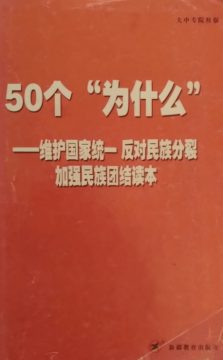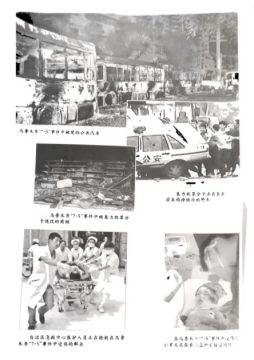‘The 50 Whys: Protecting National Unification, Opposing Ethnic Separatism, Strengthening Ethnic Unity Study Book’
For Original Materials, find here 50个’为什么’
Introduction
Following violent clashes between Han, Uyghurs, and security organs in June and July 2009, the party-state instituted compulsory “ethnic unity education” (minzu tuanjie jiaoyu 民族团结教育) in all state institutions across Xinjiang to “promote ethnic unity consciousness … with patriotism as its core content.” [1] To pass compulsory “ethnic unity” exams, schoolchildren, students, teachers, and state employees in Xinjiang were required to link their identity to official narratives of history in exams and oral repetition of official texts. Leading questions such as, “Why say that Xinjiang has always been part of the Chinese nation (Zhonghua Minzu)?” and “Why say that by 60 BCE, Xinjiang was already an inalienable part of the motherland (zuguo 祖国)?”

50 Whys book cover
The 50 Whys: Protecting National Unification, Opposing Ethnic Separatism, Strengthening Ethnic Unity Study Book (hereafter: The 50 Whys) was a key text in this campaign. The 50 Whys was published by the Xinjiang Education Press [2] and intended for study by all teachers and students at every higher educational institute in Xinjiang. It was unavailable for public purchase and marked for “internal circulation,” though it is also marked as “openly published” (gongkai chuban). It is curricular material for the schools rather than a commercial product. I was given a copy by a University staff member, because they “want the world to know the truth about 7-5” (the violence on July 5th) and “what the Uyghurs have done to us”. The text is hugely significant for scholars, the media, and policymakers today because it shows how mass internment campaigns that began under Xi Jinping build on pre-existing narratives of Uyghur threat and backwardness, intensifying, not initiating, state violence against Turkic-speaking Muslims.
The 50 Whys, like other related texts, ethnicise national-level political concepts, such as “scientific development,” explaining conversion of Uyghur identity as a natural and progressive process. They also introduce concepts rarely encountered across China because of their associations either with the Mao era or Han chauvinism, such as Han-led “fusion” (jiaorong 交融) and “ethnic extinction” (minzu xiaowang 民族消亡) of ‘minority’ identities. The 50 Whys narrates a story of Xinjiang as an indivisible component of China, describing Uyghurs as “not a Turkic minzu” and “not an Islamic minzu” because “after the Turk Khanate collapsed in the 8th century, they did not form a modern minzu” (p.57). The text describes Uyghur identification with Turks or Turkic-ness as “distortions of truth” and “distortions of history,” because since 60 BCE (Han dynasty), “every minzu identified with the command of the central government” (p.47 & 49-50).
Like State Council White Papers and other related education texts, the 50 Whys refers to complementary relations of dependence between advanced national core and backward ethnic periphery that form China, a unified, multi-ethnic nation. The provision of horses by ethnic minorities to the central plains functions to develop their own living areas (p.66). This provision complements the Han offerings of silk, tea, and all daily necessities, that “promote the development of ethnic minorities and ethnic minority regions” (p.66). Ethnic minorities provide Han with supplementary goods for further development, and in return, their very existence (“‘everything they needed for daily living’) is provided by the Han. This dependency narrative frames Han as superior while minorities are eternally backward but progressing since Xinjiang’s “peaceful liberation” (heping jiefang 和平解放) by the People’s Liberation Army (PLA) in 1949 [3]. The 50 Whys explains that the PLA peacefully liberated Xinjiang from its “backward” history of being “without tall buildings” (p.40 & 79).

Official reporting photos from the “Urumqi 7.5 Incident” (pg. 2)
Despite the need for liberation in 1949, these texts also remind readers that “the history of the Han in Xinjiang began very early – from before the time of Zhang Qian (2nd century BCE), there have always been Han living in Xinjiang” (p.50). The text frames Han-ness as the civilised national standard or post-ethnic, explicitly describing the Han as a “transcendent minzu” (chaoyue minzu 超越民族) (p.91–93). The text frames Uyghur identity as a national security threat and Han identity as a culturally neutral identity that can assimilate other groups, describing violence by Uyghurs as a “zero-sum political struggle of life or death” for China (p.15). Readers are told that only “separatists” and “terrorists” oppose the party’s monolingual education policies (90–93 & 107), framing language maintenance as an act of terrorism. The 50 Whys asserts that Uyghurs and Kazakhs today are “not a Turkic minzu” and this “mistaken identity” only exists due to dangerous influences of separatism, terrorism, and extremism (“the Three Evils”) (p.55–59). The 50 Whys then tells readers that only “separatists” and “terrorists” could understand themselves through reference to the categories of “Turk” or “Muslim” (p.47–52 & 99). However, The 50 Whys paradoxically explains ethnic policy to readers, that to maintain “religious freedom”, students and state-employees are not permitted to visit mosques or practice Islam because these “religious activities” interfere with “freedom of choice” and “modern education” (p.103–104).
Texts like this one highlight specific everyday practices of teacher and student behaviour as national security matters to be met with heightened surveillance: “All teachers, students, and staff must maintain a high level of vigilance” and “protecting the unity of the nation is a political demand and historical mission of every student” (p.102 & 107). The purpose of ethnic unity education was explained as disseminating the “truth” about “7-5” such that everyone must participate in ethnicised surveillance: “clearly distinguish enemy from self” (renqing diwo 认清敌我)’ (p.104 & 106).
Universities rounded up Uyghur students involved in the protests prior to the July 5th violence, who reported to party representatives before being confined and monitored in dormitories and sent to additional ethnic unity education classes, using the 50 Whys as a core text—indeed, this textbook was published quickly, by August, barely two months after the protests. The 50 Whys explains that these students’ “thought had problems” and they “had to learn a lesson” to “establish the correct national outlook (guojia guan 国家观), minzu outlook, religious outlook, historical outlook, and cultural outlook’ (p.105–107). The text and this summary are published here to aid scholars, media, and policymakers place current practices of mass internment in historical context and trace connections between genocide and long-term dehumanisation of Turkic-speaking Muslims. This text provides a valuable record in the words of the Chinese authorities the reflect the underlying ideas and assumptions that have come to justify what many around the world see as genocidal processes.
Annotation prepared by Dr. David Tobin
Lecturer in East Asian Studies at the University of Sheffield
Footnotes
[1] Xinjiang Uyghur Autonomous Region (XUAR) Party Commission Information Department (eds) (2009) Jiaqiang Minzu Tuanjie, Weihu Xinjiang Wending: Xuanchuan Jiaoyu Cailiao Yi (‘Strengthening Ethnic Unity, Protecting Xinjiang Stability: Information Education Materials No. 1’). Wulumuqi: Xinjiang Renmin Chubanshe (‘Xinjiang People’s Publishing Press’).
[2] There was considerable online official promotion of this text at the time, particularly by the Ministry of Information.
[3] State Council (2009) Zhongguo de Minzu Zhengce yu ge Minzu Gongtong Fanrong Fazhan (China’s Ethnic Minority Policy and the Common Prosperity of all Ethnic Groups). Beijing: Renmin Chubanshe (‘People’s Publishing Press’), p.4.
‘The 50 Whys’ Table of Contents
Translation prepared by Dr. Guldana Salimjan